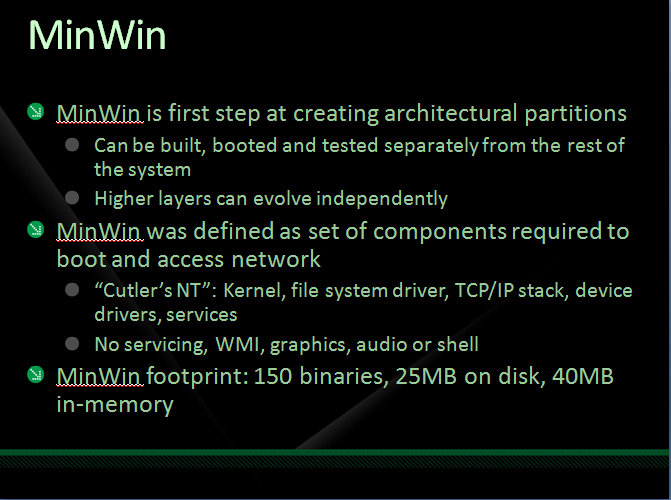More Windows 8 hints, this time on the virtualization front

Microsoft watchers have combed through a leaked slide deck about Windows 8 over the past couple of weeks for clues about Microsoft's next version of Windows. A French site, Ma-Config.com, this week unearthed some additional Windows 8 information, as well.
Granted, the new Windows 8 information is "old." It dates back to March 2009, when ITManager.com published the first part of an interview with Bernard Ourghanlian, Technical and Security Director with Microsoft France. Microsoft may have shifted its Windows plans and priorities considerably since then.
But the interview still contains some telling tidbits about Microsoft's thinking, regarding desktop virtualization and system updates which may become part of Windows 8. And given the fact that Microsoft officials said last year that systems-management/updating technologies would be key to Windows 8, I'm inclined to think at least some of what Ourghanlian discussed still holds.
(The interview is in French; I'm relying primarily on the English translation generated by Bing Translator, with a few of my own adjustments.)
Ourghanlian described the utopian Windows 8 situation: One where users would install a master of Windows on their PCs, plus possibly an antivirus program, but nothing else. All other applications would run virtually, via a combination of Hyper-V V3 (the next version of Microsoft's hypervisor technology, which would no longer be a server-only thing), App-V application virtualization technology and MED-V desktop virtualization functionality. Some of these applications would run in virtual machines that would combine applications and operating systems, i.e., an application running on Windows Vista or an application running on a particular flavor of Linux.
(Just a thought: Maybe this is what will enable the "push-button reset" capability Microsoft is said to be considering for Windows 8 will work...?)
In the ITManager.com interview, Ourghanlian explained:
"(I)f I for example Windows 8, I can imagine host images of Windows 7 systems Vista, Windows XP, or even for Linux. All this in a context where, virtualized way, I have these different systems images but in fact, the idea is to couple the two types of virtualization virtualization system and application virtualization are to ensure that applications, where they are compatible with an earlier version of the operating system but not with the current version, I can stream as App - V allows it, the virtual machine that is capable of supporting them. Therefore, the idea is for the user, this time in MED - V (Microsoft Enterprise Desktop) that will enable level shell, i.e. graphics, give the user the impression that there was a series of icons or applications which are available on his workstation thanks but, in fact, it is not known if this application is "running natively" on the native operating system of the machine or to a virtual machine. Now if we look at Virtual PC, this tool is suffering a huge disability from the perspective of the user. Based on a virtual machines, as many offices of virtual machine and therefore in fact many contexts of interaction between man and machine."
Currently, the App-V and MED-V technologies are available only to Microsoft Software Assurance licensees as part of a paid bundle known as the Microsoft Desktop Optimization Pack (MDOP). I wonder if the scenario above means Microsoft would make these virtualization technologies available to all Windows customers, not just those who pay a premium. Hmmm..
What's enabling all this, under the covers, is MinWin -- the "guts" of Windows (the kernel, hardware abstraction layer, TCP/IP, file systems, drivers and other core system services. Microsoft did include an implementation of MinWin as part of Windows 7, officials said last year. But it sounds like MinWin will be (not surprisingly) a lot further along with Windows 8.
MinWin will allow Microsoft to decouple many subsystems from the core of Windows -- including Internet Explorer, Ourghanlian confirmed. The underlying core that will be left will be the NT kernel. From the interview:
"Completion of MinWin is the possibility to make two fundamental things: you can disengage IE completely and be fully able to disengage the Shell, are things that are not yet feasible because these two elements are still too nested in Windows kernel. The goal with MinWin, when it comes with Windows 8 if everything goes well, it is to completely disconnect these features that is to ensure that potentially they are not present at all. At this time, this will allow to have, for the desktop, the equivalent of a Windows Server Core... in the case of Hyper-V V3 on the workstation is the smallest possible, both in terms of potential attack surface in terms of memory footprint and rack space disk."
(As a refresher: Here's a slide from a presentation in 2009 by Microsoft Technical Fellow Mark Russinovich that explains what MinWin is/isn't in a succint way.)
Another area where Microsoft's next-generation virtualization technology will come into play with Windows 8 is in the Windows update space, as Ma-Config.com explains in its latest blog post. Managing all the virtual machines enabled on the desktop via Hyper-V 3 will be of great importance with Windows 8. Updating virtual machines while they're turned off, as well as updating third party applications, will need to be managed via new Windows Update mechanisms, as Microsoft Kitchen blogger Stephen Chapman noted (via a Microsoft Windows 8 job post he found last year).
It's still early days for Windows 8, and as I noted from the outset, a March 2009 interview (published before Windows 7 was released to manufacturing) is pretty ancient Still, there's some good food for thought about what "might be" coming when Microsoft delivers its next version of WIndows (in 2013 or, hopefully sooner, given Apple's growing dominance in the slate PC category).
If you wade through the ITManager.com and/or Ma-Config.com posts (especially any of you fluent in French), I'd be interested in any additional take-aways you find....
